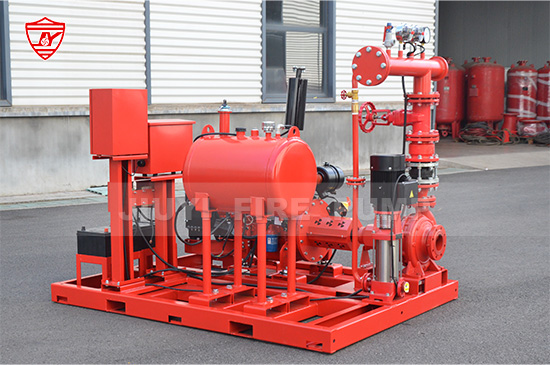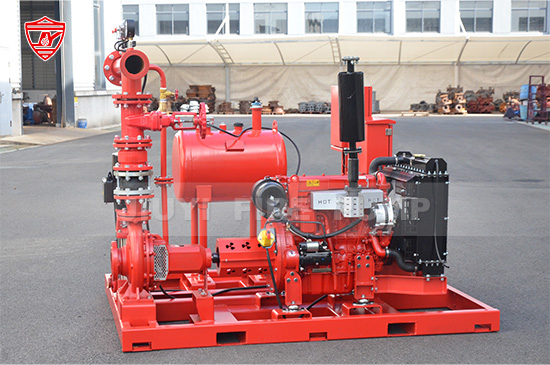A Fire Pump Automatic Transfer Switch (ATS) is a vital component in any fire protection system that ensures your fire pump continues operating when the main power source fails. In simple terms, it automatically transfers the power supply from the primary (utility) source to a backup source, such as a diesel generator, without manual intervention.
This switch guarantees that even during a power outage—often the time when a fire emergency could occur—your fire pump remains operational, maintaining water pressure to protect lives and property.
In modern building safety systems, reliability and quick response are everything. That’s why the automatic transfer switch is not merely an accessory—it’s a core safety mechanism required by NFPA 20 and other international fire protection standards.

When a fire breaks out, the last thing anyone can afford is a power failure. The fire pump is the heart of a firefighting water system, responsible for maintaining sufficient water pressure to sprinkler systems, standpipes, and hydrants. However, if the power source fails, the pump stops running—putting the entire fire protection system at risk.
The Fire Pump Automatic Transfer Switch (ATS) ensures that doesn’t happen. It continuously monitors electrical power. If it detects a failure in the normal supply, it instantly shifts the connection to the emergency power source, usually a generator or an alternate utility line.
This transition happens automatically, without any need for operator action, which is critical in emergencies when every second counts.
A Fire Pump ATS is designed to provide uninterrupted power by automatically switching between power sources. Here’s how the process works step by step:
Normal Condition:
The ATS supplies power to the fire pump from the utility source. The system operates as usual.
Power Failure Detection:
The ATS continuously monitors voltage and frequency levels. When it detects a drop or complete loss of power, it immediately sends a start signal to the emergency generator.
Transfer to Emergency Power:
Once the generator reaches the proper voltage and frequency, the ATS disconnects the utility source and connects the generator source to the fire pump motor.
Restoration of Normal Power:
When utility power is restored and stable, the ATS automatically switches the load back from the generator to the utility.
This automatic sequence ensures that the fire pump always has a reliable power source, maintaining system integrity at all times.
An ATS designed for fire pump systems includes several critical components, each serving a specific function to ensure safety and reliability:
Power Contacts: Transfer the electrical load between power sources.
Sensing Mechanism: Monitors voltage and frequency to detect power failure or restoration.
Control Logic: The “brain” of the ATS that decides when to transfer and retransfer power.
Manual Override: Allows manual operation during testing or maintenance.
Interlocking System: Prevents simultaneous connection of two power sources.
Enclosure: Protects internal components from dust, moisture, and physical damage.
Each of these elements is designed and tested according to stringent standards to ensure fail-safe operation under any condition.
According to NFPA 20: Standard for the Installation of Stationary Pumps for Fire Protection, an automatic transfer switch used in a fire pump system must meet specific performance and construction standards. It must be listed for fire pump service, meaning it’s tested and certified for reliability under fire emergency conditions.
Additionally, UL 1008A covers Transfer Switch Equipment for Fire Pump Service. UL-listed fire pump ATS devices are built to withstand high inrush currents and must maintain circuit integrity under short-circuit conditions.
A compliant ATS ensures:
Dedicated function for the fire pump system only (not shared with other loads)
Manual bypass capability
Robust mechanical interlocks
Continuous monitoring of power sources
Fire-rated enclosures when required
Choosing an ATS that meets NFPA 20 and UL standards guarantees that your fire pump will perform when it matters most.
While all fire pump ATS devices serve the same fundamental purpose, they can differ in design and operation:
Open Transition ATS (Break-Before-Make):
The standard and most commonly used type. It briefly disconnects from the normal source before connecting to the emergency source, ensuring both sources are never connected simultaneously.
Closed Transition ATS (Make-Before-Break):
Allows both sources to overlap for a fraction of a second to prevent power interruption. Used in systems where even a split-second outage cannot be tolerated.
Bypass Isolation ATS:
Includes an additional bypass switch that allows maintenance or testing without interrupting the power supply to the fire pump.
Each type has specific advantages depending on the building’s electrical design, generator capacity, and fire safety requirements.
Installing a Fire Pump Automatic Transfer Switch requires careful planning and compliance with electrical and fire protection standards. Here are key best practices:
Dedicated Installation:
The ATS must serve only the fire pump—no other equipment or building load should share its circuit.
Proper Location:
It should be installed close to the fire pump controller to minimize cable length and voltage drop.
Routine Testing:
Regularly simulate a power failure to confirm the ATS transfers properly and the generator starts as expected.
Visual Inspection:
Check for loose connections, corrosion, or overheating marks on terminals and contacts.
Recordkeeping:
Maintain a log of all test results, inspections, and maintenance activities for compliance verification.
Proper installation and preventive maintenance not only extend the ATS’s lifespan but also ensure your fire protection system remains fully operational during emergencies.
The use of a Fire Pump ATS provides several important advantages for building owners, engineers, and safety managers:
Uninterrupted Operation: Keeps fire pumps running automatically during power failure.
Compliance with Standards: Meets NFPA 20 and UL requirements for fire protection systems.
Improved Safety: Reduces risk to life and property by ensuring reliable fire suppression capability.
Automatic Functionality: Eliminates the need for manual intervention during emergencies.
System Integrity: Protects fire pump motors and control equipment from voltage fluctuations.
Reduced Downtime: Ensures faster response and recovery during and after power outages.
For high-rise buildings, hospitals, data centers, and industrial facilities, this reliability is not optional—it’s essential.
Choosing the appropriate ATS for your fire pump system depends on several factors:
Power Rating: Match the ATS’s current and voltage rating with the fire pump motor requirements.
Listing and Certification: Ensure it’s UL-listed for fire pump service and complies with NFPA 20.
Type of Power Sources: Determine whether your backup source is a generator or an alternate utility.
Transition Type: Choose open or closed transition based on operational needs.
Environmental Conditions: Select an enclosure rated for the installation environment (indoor, outdoor, marine, or hazardous).
Consulting with experienced fire pump manufacturers and system integrators can help you choose a switch that ensures both compliance and reliability.

A Fire Pump Automatic Transfer Switch (ATS) is more than a backup device—it’s the silent guardian of your fire protection system. It guarantees that, regardless of power conditions, your fire pump will activate and perform when needed most.
By selecting a UL-listed, NFPA 20–compliant, and reliably engineered ATS, you ensure your fire system maintains continuous operation, protecting both life and property in every emergency.
In fire safety, reliability isn’t just a feature—it’s a responsibility. And a properly designed Fire Pump Automatic Transfer Switch is the key to upholding that standard.